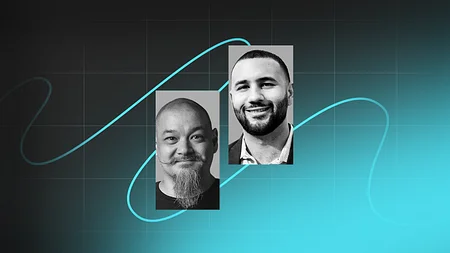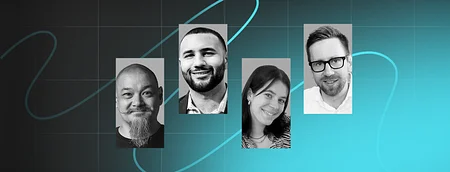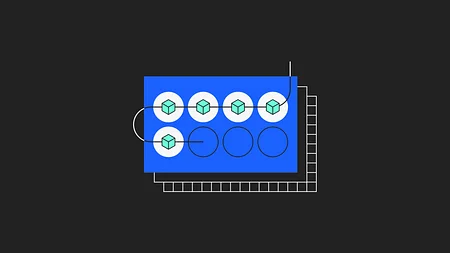Block.one on EOS, token sales and decentralisation
Simon Taylor interviewed block.one CEO and CTO Brendan Blumer and Daniel Larimer at Blockchain Live, to find out more about what block.one does and their new project, EOS that achieved $50omillion in fundraising.
How did you get to be in block.one, and what is block.one?
BB: Block.one is a publishing company of decentralised autonomous corporations. We think that a properly constructed DAC is very similar to a big, online video game, in the sense that, you take the time to build a proper technological framework, combine that with a community, and it produces positive externalities. In the case of video games, you’re looking at something like entertainment, but with DACs, you’re looking at real world provisions of goods and services for problem solving.
DL: I got into the cryptocurrency industry very early, as I was trying to come up with a decentralised currency, and my mission in life is to find free market solutions for securing life, liberty and property, and blockchain technology is the core technology behind almost every solution in that range. So, I’ve been in the industry for a while, I’ve done several projects, including BitShares, which are a decentralised exchange, and Steem, which is the decentralised social media, where you get paid to post, and Steem being the first blockchain that’s so easy to use you don’t even realise you’re using a blockchain.
I recently joined up with block.one for the purpose of generalising the technology, to allow other people to build things like BitShares and Steem.
What problem do you guys solve, fundamentally?
BB: There has been a gap, between what we know this technology is capable of, and what we can actually do with the existing platforms.
If you take a look at platforms like Bitcoin and Ethereum, while they have introduced the concept of peer to peer value transfer, we’re really limited in throughput, performance and the cost of these machines. If you’re looking at a single day, with about four transactions a second, Ethereum’s paying about 6 million US dollars for mining. So that puts us at about 17 US dollars per transaction, before additional fees. The problem is, smart contracts are expensive and hard to build, and so you need large amounts of volume to monetise them, and how can you get started, and really roll something out, when you don’t even have the output on the networks to monetise the effort that went in, in the first place.
DL: I’d like to answer the same question. The fundamental problem we’re trying to solve as a society is consensus. It’s a very slow process. But with blockchains, we can reach consensus every single minute, and what we’re trying to do with blockchain technology is take it down so every second we can reach consensus, and we can reach consensus that quickly on all manner of things. It facilitates faster financial transactions, you have greater certainties, and so it’s all about, as a human race, how can we come to an agreement on something, when we all see things from very different perspectives?
"What we’re trying to do with blockchain technology is take it down so every second we can reach consensus, and we can reach consensus that quickly on all manner of things."
People often complain about the blockchain not being fast enough, not being cheap enough, and so to have a project trying to address that makes a lot of sense. You’ve raised nearly $500 million in total now, why do you need that much money?
BB: In the past, we would say, “Okay, here’s our business model, here’s our budget, we need this amount of money,” and you’d go ahead and raise for it. But this industry works a little bit differently, because we need to preserve the integrity of distribution. When we set out to build the right type of community, we said, “What does it take to build the best community? To have the most distributed network? How much would Bitcoin be worth if it was distributed in 20 minutes for $10 million?” Probably nothing.
So, you have to prioritise one or the other, and what we’ve done is we’re building a community which scales infinitely, right? And so, the amount of capital that we’ve taken in reflects the size of the community that we’ve built, and we’re planning ways to share that capital with the people that are in a position to influence the space, so that we can grow the ecosystem, not just on a technological level, but foster the innovation that’s going to drive the adoption of the software.
DL: The distribution of a token is incredibly important for decentralisation of control. If you have too much power concentrated in too few hands, then the system’s not actually decentralised, and the people who have that undue influence might have different interests than everyone else. But when you have everyone more evenly distributed, then that actually contributes directly to the decentralisation, and that’s incredibly important in proof of stake systems, where the tokens influence your control over the system.
"The amount of capital that we’ve taken in reflects the size of the community that we’ve built, and we’re planning ways to share that capital, so that we can grow the ecosystem"
Tokens influence control, but who’s holding these tokens? If you guys have $500 million, how are you incentivising the community to work on that?
BB: It’s good to understand what the tokens represent. So, block.one is an independent publisher. If you look at it from the standpoint of Microsoft and publishing Windows, right, you would create and launch Windows, and Microsoft own that technology, and they still own it today and they still monetize it. Whereas, if you take a look at something like EOS, during the course of this distribution, we passed the control and beneficial interest in that project over to the community from day one. What people are buying in to, when they buy a token, they’re buying in to a community, and they’re operating under the assumption that that community is going to produce more value than what they’re putting in.
If I’m a token holder, I am seeing an ability to use those tokens to do something. But can you make that real for me? What are people building using EOS? What can I do with those?
DL: One of the products we introduced is a software that the block producers can run, is the ability to do storage. Decentralised YouTube. Where, for the first time, you don’t have to pay monthly fees to store and host your website. Just by having tokens, the community will host your website for you, with high bandwidth, high availability. Decentralised use is just one aspect of it. You can create decentralised exchanges. Basically, these tokens give you the ability to consume limited resources, the storage, computational and bandwidth restrictions, because everyone, collectively, is producing that and contributing to it. Block.one is not the one providing these services. We create the software that enables the community to provide services to each other, and that’s a key distinction between securities and non-securities.
BB: And that’s also what allows us to build a true, decentralised, autonomous organisation. EOS is really one of the first projects released in recent years that actually has no dependency on any centralised entity, individual, or even a foundation.
"Basically, these tokens give you the ability to consume limited resources, the storage, computational and bandwidth restrictions, because everyone, collectively, is producing and contributing to it." - Dan Larimer
So, how does that decentralised entity stay disciplined and make decisions? What does that governance process really look like?
DL: Well, EOS, the token holders, they select block producers, 20 or more block producers, and they direct which direction the blockchain’s going to go. They can also elect what we call community benefit contracts. These are special smart contracts that can define their own governance processes and permissions, and they receive the authority to distribute new tokens, and those new tokens can fund development. Each and every day, Bitcoin and Ethereum are spending $5 million to $10 million on burning electricity. We create a decentralised organisation that allows the community to funnel those resources back in to grow the resources and storage, computation, or anything else that they might want to do, like rewarding posts on Steemit.
$500 million for a decentralised organisation is a lot in real, fiat money. How is the governance around how that fiat money is managed and distributed? So, we’ve talked about the tokens, but what about the fiat side of that?
DL: The money we take in is revenue to block.one and we’re using it to grow the interest of our shareholders at block.one.
BB: We’ll be announcing very shortly how we plan to use that capital, to reinvest into the ecosystem to grow. We maintain a stake in the tokens, for a long period of time, over ten years, and so we’re heavily invested, and we’re big believers that the 10% of tokens we hold, in the long run, are likely going to be worth much greater than what we take in from this token sale over the next year.
What you’re going to hear pretty soon is how we’re spending that money, not to necessarily just build the tech. You’re right. We can’t spend $500 million laying the rails of this technology, but what we can do is take that $500 million and put it in the hands of the people that are working with the entrepreneurs now, start exposing the product, building the ecosystem, and what we’re actually doing is we’re diverting, like Dan said, the resources that would normally go to burning more electricity than small countries, to process a nominal amount of transactions per second, and we’re circulating that back to the innovators.
Right now, you’ve got 95% of the capital going to almost none of the innovation. I believe that we need to change this. Can you imagine, if we were taking in $20 million, $30 million a day, if we were burning 80% of it? And so a project like EOS has the capacity to take that in, reinvest it into the ecosystem, potentially even leverage it up through additional financing sources, and then drive unprecedented amounts, or drive this amount of capital back to the entrepreneurs who are really creating the innovation in this space.
To listen to the interview in full, check out Blockchain Insider, episode 12! For more information on EOS, visit EOS.io, or for more interviews and insights like this one, subscribe to Blockchain Insider."Right now, you’ve got 95% of the capital going to almost none of the innovation. I believe that we need to change this." - Brendan Blumer




